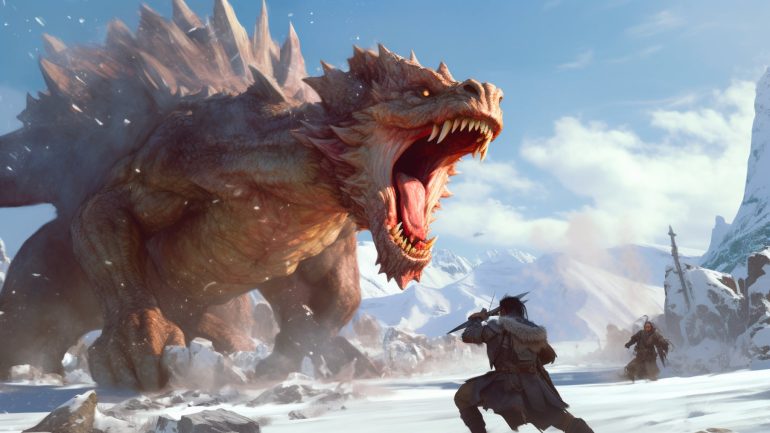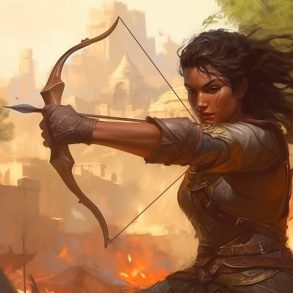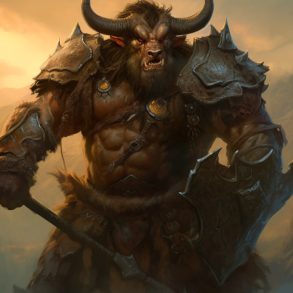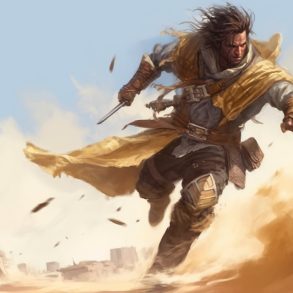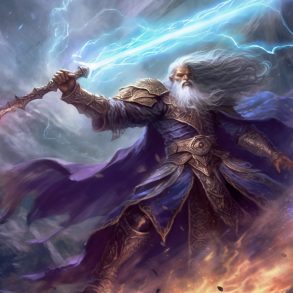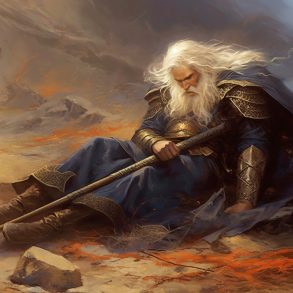Dice Cove may receive a commission for purchases made through links on our site. Learn more.
In DnD 5E each player commands a heroic fantasy character destined to wield wondrous powers against all kinds of challenges and opponents. Just as Conan the Barbarian wields a mighty weapon into battle; your character can also choose to gain unique powers and abilities which set them apart from other adventurers. We do this through the optional rule for character customization known as Feats.
What makes DnD 5E feats a popular customization option?
Feats give your character a distinctive specialization. Each feat empowers a different aspect of your character. Choose the feat that signifies what makes your character unique. You can choose to gain a feat instead of receiving an ability score improvement.
While feats are an optional rule, it’s most likely that your dungeon master will encourage them in your game. Like multiclassing, feats have been a popular component of the game since they were first introduced in 3rd edition. Feats are not available until level 4, except for variant humans. Variant humans gain a feat at level 1. This is the only way that a character can have a feat before 4th level.
When do you get Feats in 5E?
You can choose a feat at 4th level, with further choices before your character reaches 20th level. Each class has a different interval of selection, so check your class description to plan your choices. With two more choices at 6th and 14th level, Fighters offer the most opportunity for character customization. Rogues get one more option at 10th level.
| Class | Feat | Notes |
|---|---|---|
| Barbarian | Great Weapon Master | Requires use of a heavy weapon. |
| Bard | Actor | Charisma boost and deception. |
| Cleric | Tough | Boosts your hit points. |
| Druid | Observant | Boosts your perception. |
| Fighter | Sentinel | Enhances opportunity attacks. |
| Monk | Mobile | Avoids opportunity attacks. |
| Paladin | Inspiring Leader | Extra hit points for your party. |
| Ranger | Sharpshooter | More powerful ranged shots. |
| Rogue | Alert | Can’t be surprised. |
| Sorcerer | Spell Sniper | Add an extra cantrip such as Eldritch Blast. |
| Warlock | Elven Accuracy | Even better Eldritch Blasts! Only applies to Elves and Half-Elves. |
| Wizard | War Caster | Maintain spell concentration. |
Why should i choose a DnD 5E feat?
A feat enhances one aspect of your character with a more powerful ability; with something unique, or an extra option to choose from. For example, to represent Conan the Barbarian with his mighty greataxe or greatsword, you can use the Great Weapon Master feat. This feat deals extra damage in wild sweeping blows. The feat also grants you an extra weapon attack on your turn when you drop a foe to the ground. A Great Weapon Master attack adds a new aspect to your game, but you’ll take a penalty on your attack roll. Around the table, your fellow players will watch to see if you will attempt a mighty strike amid a fierce battle. And when you do crush an enemy, you’ll surprise them by declaring your extra attack to finish off the fight.
When not to choose a DnD Feat
Choosing a feat comes with a cost though, as you have to give up an ability score improvement to do so. For spell casters, it’s advisable to increase your spellcasting ability before choosing a feat. This means that your spell save Difficulty Class (DC) will be as high as possible. It’s not a great feeling when a high-level spell that you’ve been saving up for that big fight fizzles away!
Bear in mind that your ability score modifier increases each time your ability score reaches an even number. Certain feats can boost your ability scores by one point. So if your ability score is an odd number, and you choose a feat that boosts that ability score, the ability score modifier will also increase. Magic items too can play a part in boosting your abilities, so remember that when planning your character progression.
Feats In DnD Beyond
In DnD Beyond, you can find the feats published in the Player’s Handbook, Xanathar’s Guide to Everything, and other sourcebooks, as well as the Unearthed Arcana playtest material. There’s also a vast selection of over 8,000 homebrew feats available for you to add to your game. Take a look at the Dungeon Masters Guild, where at a low cost or even free of charge, you’ll find over 1,500 different sources each offering new feats to try.
Homebrew DnD Feats
Talk with your DM first about using homebrew feats in your game. Let’s take a look at two example homebrew feats that you can find in DnD Beyond:
- Feline Grace is a homebrew Tabaxi racial feat. This feat boosts dexterity and the Feline Agility trait, and also grants limited immunity to falling damage. This feat makes up for the lack of a Tabaxi racial feat in Xanathar’s Guide and grants a boost to the cat-like features of this race.
- Ventriloquist is a homebrew social skill feat. This feat provides a Charisma boost, as well as the chance to throw your voice as a deception. This feat could be useful in a game where social situations are common.
DnD Feats In Tal’Dorei
In Critical Role’s world of Tal’Dorei and Exandria, you can recreate the adventures of Vox Machina through the nine feats available in the Tal’Dorei Campaign Setting. Here are a few:
- Thrown Arms Master which improves thrown weapons.
- Dual Focused which enables a second concentration spell.
- Rapid Drinker which permits a bonus action to drink a potion.
Elite DnD Feats
As mentioned, Great Weapon Master is a powerful feat for Barbarians (such as Grog Strongjaw) but it’s also favored by melee fighters in general.
Of the spellcasting feats, War Caster wins the popular vote. This combat feat protects your magic-user from breaks in concentration and you can cast a spell as an opportunity attack. Not only that but casting a spell without a free hand is also a feature of this feat.
For ranged characters, Sharpshooter is the feat of choice. Like Great Weapon Master, this feat allows ranged attacks to choose a higher damage option with a penalty on accuracy. Declaring a Sharpshooter attack on your turn adds a touch of excitement to the battle. Extra range and ignoring cover are also added benefits.
Elven Accuracy from Xanathar’s Guide to Everything is popular for Elf or Half-Elf characters. This feat enables a reroll on your non-strength-based attacks with advantage; this includes ranged weapons as well as spell attacks. This means you will roll more natural 20s, and the high-fives will abound as you fight your way through to the final boss.
Which DnD Feat to pick first?
Not sure where to start? I’ve chosen one feat for each class and listed them in this table. You can’t go wrong with any of these feats, and this table provides an easy way to select your first feat.
[table id=8 responsive=scroll /]
So in the table above, I’ve given you a starting feat for each of the main classes in the Player’s Handbook. Now let’s look at more feats in some sample builds. I’ll explore one subclass for each class, and provide two options in each subclass.
DnD Feat focused builds
The following examples each have two feats selected before level 10. These builds focus on feats over ability score increases.
Barbarian
The Ancestral Guardian is a Barbarian tank subclass, and what better race than the stubborn Mountain Dwarf. The ideal feat for this subclass is Shield Master. As a tank, you’ll be carrying a shield anyway. Shield Master gives you a bonus action to keep your opponents at bay. Furthermore, it grants defense against some spell attacks and traps. Your Dwarf Ancestral Guardian will fit into the archetypal role of axe-bearer that holds the enemies at bay while your allies move to safety. As a second feat at 8th level, take the Dwarven Fortitude racial feat for its self-heal capability.
Bard
A College of Eloquence Bard (Mythic Odysseys of Theros) plays the role of the party face with outstanding flair. Select Half-Elf and you will receive a round of applause each time you save them from a sticky situation. Just to be on the safe side, take the Skilled feat and gain proficiency in three more skills at 4th level. As a Half-Elf, you have two skill proficiencies. As a bard, you can choose expertise in two of these skills at 3rd level, and two more at 10th level. For a second feat at 8th level take the Prodigy feat to bring you up to 11 skill proficiencies.
Cleric
A Light Domain Cleric is a powerful damage dealer for your party. A Protector Aasimar grants a suite of useful features including a wisdom bonus and extra healing. Take the Elemental Adept (Fire) feat at 4th level, to make your fire spells more effective. As a Light Cleric, you have six Domain Spells that deal fire damage. At 8th level, take the Resilient feat in constitution. This will increase your constitution score and it will add proficiency in constitution saving throws. This helps your concentration spells such as Bless, Flaming Sphere and Spiritual Weapon stay in play.
Druid
The Circle of the Shepherd Druid is the animal lover the party didn’t know they needed. Take the Wood Elf race for the wisdom bonus and hide ability which you can use in wild shape. In wild shape you can use your feats as well. Choose the Mobility feat. This boosts your movement speed, and it grants the ability to move without provoking an opportunity check while in wild shape. Improved movement adds flexibility to your Spirit Totem too. On a larger battlefield, you can place the Spirit Totem where it will deliver the most benefit to the party. Then at 8th level take the Wood Elf Magic racial feat to improve your spellcasting capability.
Fighter
The Eldritch Knight brings spell casting to the fighter class and delivers more versatility as a melee fighter. High Elf is a natural choice with their extra intelligence and extra cantrip. Choose the Dueling fighting style for extra damage and carry a longsword and shield. Take the War Caster to allow you to cast spells requiring material or somatic components. Somatic components are the hand gestures that you see on the Syfy show The Magicians. This means you can use spells such as Shield, Booming Blade or Green Flame Blade. With War Caster and an armor class boost from a Shield spell, you can maintain spell concentration easier. At 6th level, take the Fey Teleportation racial feat to add the Misty Step spell to your spellcasting choices. At 7th level, when you get access to Shadow Blade, War Caster will be invaluable. At 8th level take an ability score increase in strength if you don’t have a magic item to boost your strength score.
Monk
The Way of the Drunken Master is the comedic Monk subclass that adds more versatility to melee combat. Take a standard Human. Your Flurry of Blows is stronger with this subclass and you have more freedom to move in battle. At 4th level, take the Durable feat, as you’ll have bruises after every fight. At 8th level take the Tough feat to gain a hit point boost which scales with your progression. These two feats enhance the role of the Drunken Master Monk as a close combat specialist.
Paladin
An Oath of Conquest Paladin is your party’s crowd controller. This time take a Variant Human and choose the Polearm Master feat. Your weapon reach increases the number of opponents that you can attack, and grants opportunity attacks when they approach you. At 2nd level choose Great Weapon Fighting for your Fighting Style. At 4th level increase your charisma ability so that your Conquering Presence is more effective. At 7th level, fear effects from your Channel Divinity or spells such as Wrathful Smite are now more effective. Take the Sentinel feat at 8th level to further enhance your crowd control capability in melee combat.
Ranger
The Hunter is a versatile Ranger subclass, and this example is a dexterity based melee damage dealer. Take the Tabaxi and imagine its raking claws tearing down your enemies. Choose Fiends as your favored enemy. Take the Two-Weapon Fighting Style at 2nd level and start wielding two shortswords. At 3rd level choose Colossus Slayer to increase your damage output. At 4th level take the Dual Wielder feat and now you’re fighting with two rapiers. At 7th level choose Escape the Horde, since you’ve got nine lives. At 8th level take the Defensive Duelist feat which boosts your armor class and scales as you progress.
Rogue
As a Rogue with the Thief subclass, you’re the trusted hands of the party, and who better suited to this role than the Lightfoot Halfling. At 4th level take the Dungeon Delver feat to deal with traps and secret doors. As a Rogue, you’re expected to do this job anyway, so you might as well make the most of it. At 8th level take the Second Chance racial feat which uses your reaction to avoid an attack.
Sorcerer
As a Shadow Magic Sorcerer, you assist your party and also harm and debuff your opponents from a distance. Choose a Tiefling to maximize your charisma score and gain extra charisma based spells. At the 4th level, take the Infernal Constitution racial feat to boost your survivability. The constitution boost will also help with your spellcasting concentration. At 8th level take Flames of Phlegathos racial feat which will increase your Fireball damage and also boost your spellcasting ability score.
Warlock
A Hexblade Warlock is a magical melee specialist. Choose a Dragonborn to gain a breath weapon which is useful at close range. At 3rd level choose Pact of the Blade as your Pact Boon. At 4th level choose the Dragon Fear racial feat to boost your charisma, and to gain a charisma based fear breath weapon. At 8th level take the War Caster feat to enhance your spell concentration capability to maintain your Hexes. For your invocations take Improved Pact Weapon, Agonizing Blast, Thirsting Blade and Eldritch Smite.
Wizard
A Wizard of the School of Abjuration is a magical defender, especially effective against spell casters. Choose a Forest Gnome and gain the benefit of magic resistance through Gnome Cunning as well as an intelligence boost. At 4th level take the Observant feat to boost your passive skills, and also your intelligence. At 8th level take the Fade Away racial feat to further boost intelligence and provide a survivability feature.
Where to from here?
You’ll find over 40 feats available in the Player’s Handbook and 15 feats for the core races in Xanathar’s Guide to Everything. Note the prerequisites which are the requirements you need to meet before selecting each feat. You can purchase a physical or digital copy of the Player’s Handbook and Xanathar’s Guide to Everything to read the full description for each feat.
I had to save the best for last, with Lucky being an all-round useful feat for any character to take. Using 3 luck points a day, you can change the course of events for you and your party. Even Conan the Barbarian will need a little luck sometimes! Happy adventuring…
Dice Cove may receive a commission for purchases made through links on our site. Learn more.
